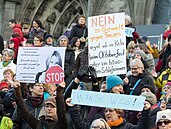
Back أزمة المهاجرين إلى أوروبا Arabic Crisis migratoria n'Europa AST Avropa miqrant böhranı Azerbaijani اوروپا کؤچریلر بؤحرانی AZB Euruopas mėgrantu bieda BAT-SMG Еўрапейскі міграцыйны крызіс (2015) Byelorussian Европейска мигрантска криза Bulgarian ২০১৫-এ ইউরোপীয় অভিবাসী সংকট Bengali/Bangla Evropska izbjeglička kriza BS Crisi dels refugiats a Europa Catalan
From top, left to right: Map of crisis,[a] Operation Triton, Refugees at Skala Sykamias Lesvos, Protesters at "Volem acollir" ("We want to welcome"), Protesters after New Year's Eve sexual assaults in Germany | |
| Date | 2014–2016 |
|---|---|
| Location | |
The 2015 European migrant crisis was a period of significantly increased movement of refugees and migrants into Europe, namely from the Middle East. An estimated 1.3 million people came to the continent to request asylum,[2] the most in a single year since World War II.[3] They were mostly Syrians,[4] but also included a significant number of people from Afghanistan, Pakistan, Iraq, Nigeria, Eritrea,[5] and the Balkans.[6] The increase in asylum seekers has been attributed to factors such as the escalation of various wars in the Middle East and ISIL's territorial and military dominance in the region due to the Arab Winter, as well as Lebanon, Jordan, and Egypt ceasing to accept Syrian asylum seekers.[7]
The EU attempted to enact some measures to address the problem,[8] including distributing refugees among member countries, tackling root causes of emigration in the home countries of migrants, and simplifying deportation processes.[9] However, due to a lack of political coordination at the European level, the distribution of countries was unequal, with some countries taking in many more refugees than others.
The initial responses of national governments varied greatly.[9] Many European Union (EU) governments reacted by closing their borders, and most countries refused to take in the arriving refugees. Germany would ultimately accept most of the refugees after the government decided to temporarily suspend its enforcement of the Dublin Regulation. Germany would receive over 440,000 asylum applications (0.5% of the population). Other countries that took in a significant number of refugees include Hungary (174,000; 1.8%), Sweden (156,000; 1.6%) and Austria (88,000; 1.0%).
The crisis had significant political consequences in Europe. The influx of migrants caused significant demographic and cultural changes in these countries. As a consequence, the public showed anxiety towards the sudden influx of immigrants, often expressing concerns over a perceived danger to European values.[10] Political polarization increased,[11] confidence in the European Union fell,[12] and many countries tightened their asylum laws. Right-wing populist parties capitalized on public anxiety and became significantly more popular in many countries. There was an increase in protests regarding immigration and the circulation of the white nationalist conspiracy theory of the Great Replacement.[13] Nonetheless, despite the political consequences, a 2023 study leveraging quantified economic metrics (such as chained GDP and the inflation rate) concluded that the events ultimately resulted in a “low but positive impact” to the German economy.[14]
- ^ "Asylum quarterly report – Statistics Explained". ec.europa.eu. Archived from the original on 26 July 2019. Retrieved 17 December 2018.
- ^ Barlai, Melani; Fähnrich, Birte; Griessler, Christina; Rhomberg, Markus, eds. (2017). The migrant crisis: European perspectives and national discourses. Peter Filzmaier (preface). LIT Verlag Münster. ISBN 978-3-643-90802-5. OCLC 953843642. Archived from the original on 24 February 2024. Retrieved 23 August 2021.
- ^ Dumont, Jean-Christophe; Scarpet, Stefano (September 2015). "Is this humanitarian migration crisis different?" (PDF). Migration Policy Debates. OECD. Archived (PDF) from the original on 30 July 2021. Retrieved 23 August 2021.
- ^ Ayaz, Ameer; Wadood, Abdul (Summer 2020). "An Analysis of European Union Policy towards Syrian Refugees" (PDF). Journal of Political Studies. 27 (2): 1–19. eISSN 2308-8338. ProQuest 2568033477. Archived (PDF) from the original on 30 January 2023. Retrieved 30 January 2023.
- ^ "FACTBOX-How big is Europe's refugee and migrant crisis?". Thomson Reuters Foundation News. 30 November 2016. Archived from the original on 16 October 2021. Retrieved 14 October 2021.
- ^ "Migrant crisis: Explaining the exodus from the Balkans". BBC News. 8 September 2015. Archived from the original on 9 March 2022. Retrieved 9 March 2022.
- ^ Zaragoza-Cristiani, Jonathan (2015). "Analysing the Causes of the Refugee Crisis and the Key Role of Turkey: Why Now and Why So Many?" (PDF). EUI Working Papers. Robert Schuman Centre for Advanced Studies. Archived (PDF) from the original on 7 August 2021. Retrieved 7 August 2021.
- ^ Hatton, Tim (2020). European asylum policy before and after the migration crisis (PDF). IZA World of Labor. Archived (PDF) from the original on 19 May 2023. Retrieved 19 May 2023.
- ^ a b Nugent, Neil (2017). "Setting the Scene: The 'Crises', the Challenges, and Their Implications for the Nature and Operation of the EU". The government and politics of the European Union (8th ed.). Palgrave Macmillan. pp. 1–20. ISBN 978-1-137-45409-6.
- ^ Cite error: The named reference
:11was invoked but never defined (see the help page). - ^ Cite error: The named reference
:14was invoked but never defined (see the help page). - ^ Cite error: The named reference
Oxfordwas invoked but never defined (see the help page). - ^ Cite error: The named reference
:22was invoked but never defined (see the help page). - ^ Solinsky, Irish (3 February 2023). "The 2015 Migrant Crisis: An Impact to Germany?". Doctoral Dissertations and Projects.
Cite error: There are <ref group=lower-alpha> tags or {{efn}} templates on this page, but the references will not show without a {{reflist|group=lower-alpha}} template or {{notelist}} template (see the help page).




